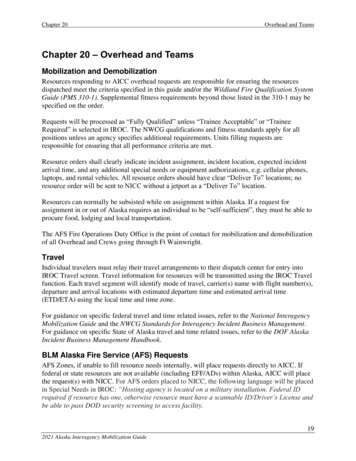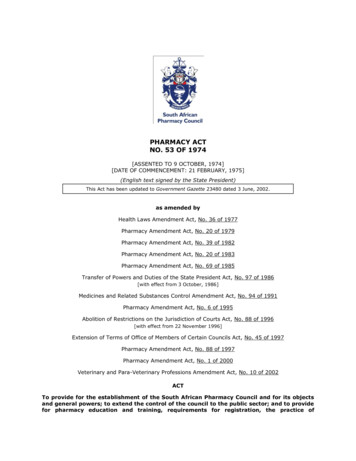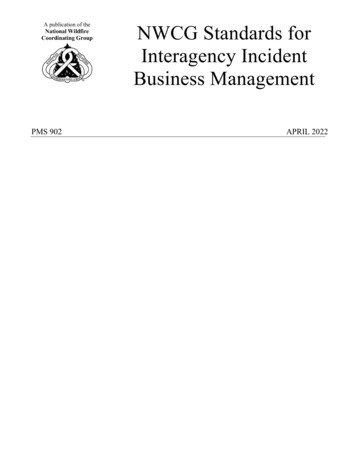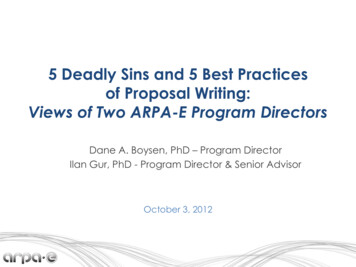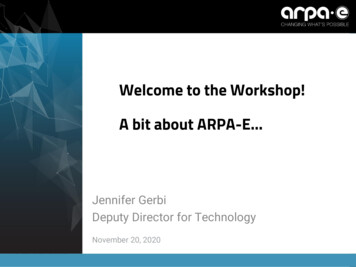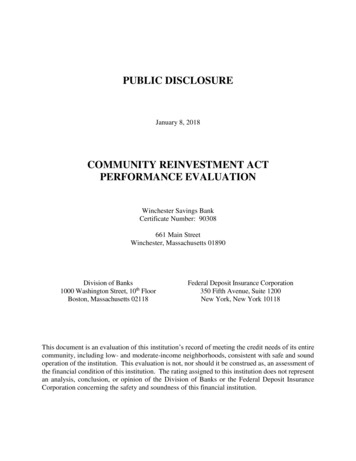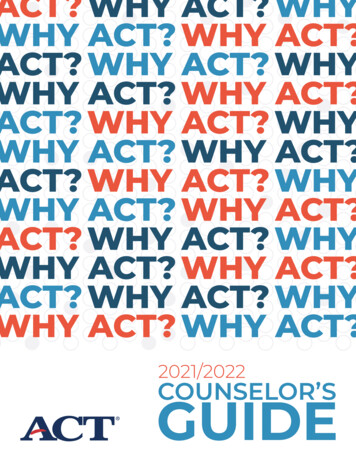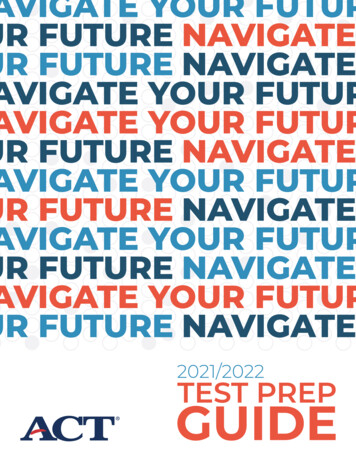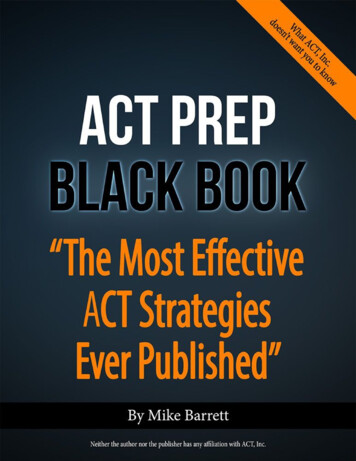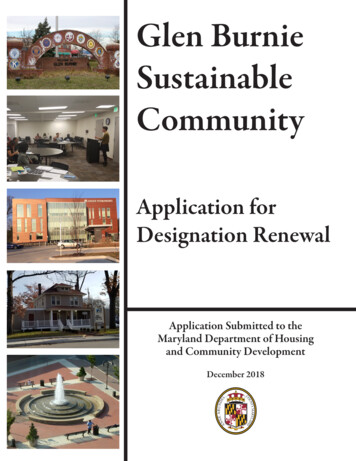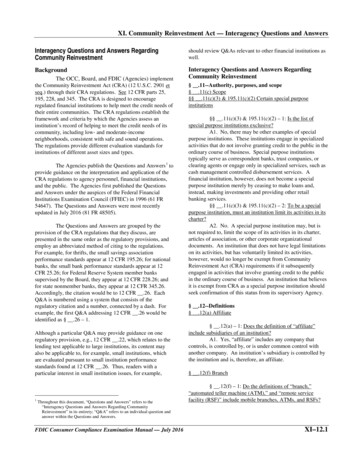
Transcription
XI. Community Reinvestment Act — Interagency Questions and AnswersInteragency Questions and Answers RegardingCommunity ReinvestmentBackgroundThe OCC, Board, and FDIC (Agencies) implementthe Community Reinvestment Act (CRA) (12 U.S.C. 2901 etseq.) through their CRA regulations. See 12 CFR parts 25,195, 228, and 345. The CRA is designed to encourageregulated financial institutions to help meet the credit needs oftheir entire communities. The CRA regulations establish theframework and criteria by which the Agencies assess aninstitution’s record of helping to meet the credit needs of itscommunity, including low- and moderate-incomeneighborhoods, consistent with safe and sound operations.The regulations provide different evaluation standards forinstitutions of different asset sizes and types.The Agencies publish the Questions and Answers 1 toprovide guidance on the interpretation and application of theCRA regulations to agency personnel, financial institutions,and the public. The Agencies first published the Questionsand Answers under the auspices of the Federal FinancialInstitutions Examination Council (FFIEC) in 1996 (61 FR54647). The Questions and Answers were most recentlyupdated in July 2016 (81 FR 48505).The Questions and Answers are grouped by theprovision of the CRA regulations that they discuss, arepresented in the same order as the regulatory provisions, andemploy an abbreviated method of citing to the regulations.For example, for thrifts, the small savings associationperformance standards appear at 12 CFR 195.26; for nationalbanks, the small bank performance standards appear at 12CFR 25.26; for Federal Reserve System member bankssupervised by the Board, they appear at 12 CFR 228.26; andfor state nonmember banks, they appear at 12 CFR 345.26.Accordingly, the citation would be to 12 CFR .26. EachQ&A is numbered using a system that consists of theregulatory citation and a number, connected by a dash. Forexample, the first Q&A addressing 12 CFR .26 would beidentified as § .26 – 1.Although a particular Q&A may provide guidance on oneregulatory provision, e.g., 12 CFR .22, which relates to thelending test applicable to large institutions, its content mayalso be applicable to, for example, small institutions, whichare evaluated pursuant to small institution performancestandards found at 12 CFR .26. Thus, readers with aparticular interest in small institution issues, for example,1Throughout this document, “Questions and Answers” refers to the“Interagency Questions and Answers Regarding CommunityReinvestment” in its entirety; “Q&A” refers to an individual question andanswer within the Questions and Answers.FDIC Consumer Compliance Examination Manual — July 2016should review Q&As relevant to other financial institutions aswell.Interagency Questions and Answers RegardingCommunity Reinvestment§ .11--Authority, purposes, and scope§ .11(c) Scope§§ .11(c)(3) & 195.11(c)(2) Certain special purposeinstitutions§§ .11(c)(3) & 195.11(c)(2) – 1: Is the list ofspecial purpose institutions exclusive?A1. No, there may be other examples of specialpurpose institutions. These institutions engage in specializedactivities that do not involve granting credit to the public in theordinary course of business. Special purpose institutionstypically serve as correspondent banks, trust companies, orclearing agents or engage only in specialized services, such ascash management controlled disbursement services. Afinancial institution, however, does not become a specialpurpose institution merely by ceasing to make loans and,instead, making investments and providing other retailbanking services.§§ .11(c)(3) & 195.11(c)(2) – 2: To be a specialpurpose institution, must an institution limit its activities in itscharter?A2. No. A special purpose institution may, but isnot required to, limit the scope of its activities in its charter,articles of association, or other corporate organizationaldocuments. An institution that does not have legal limitationson its activities, but has voluntarily limited its activities,however, would no longer be exempt from CommunityReinvestment Act (CRA) requirements if it subsequentlyengaged in activities that involve granting credit to the publicin the ordinary course of business. An institution that believesit is exempt from CRA as a special purpose institution shouldseek confirmation of this status from its supervisory Agency.§ .12--Definitions§ .12(a) Affiliate§ .12(a) – 1: Does the definition of “affiliate”include subsidiaries of an institution?A1. Yes, “affiliate” includes any company thatcontrols, is controlled by, or is under common control withanother company. An institution’s subsidiary is controlled bythe institution and is, therefore, an affiliate.§ .12(f) Branch§ .12(f) – 1: Do the definitions of “branch,”“automated teller machine (ATM),” and “remote servicefacility (RSF)” include mobile branches, ATMs, and RSFs?XI–12.1
XI. Community Reinvestment Act — Interagency Questions and AnswersA1. Yes. Staffed mobile offices that are authorizedas branches are considered “branches,” and mobile ATMs andRSFs are considered “ATMs” and “RSFs.”§ .12(f) – 2: Are loan production offices (LPO)branches for purposes of the CRA?A2. LPOs and other offices are not “branches”unless they are authorized as branches of the institutionthrough the regulatory approval process of the institution’ssupervisory Agency.§ .12(g) Community development§ .12(g) – 1: Are community developmentactivities limited to those that promote economicdevelopment?A1. No. Although the definition of “communitydevelopment” includes activities that promote economicdevelopment by financing small businesses or farms, the ruledoes not limit community development loans and services andqualified investments to those activities. Communitydevelopment also includes community- or tribal-based childcare, educational, health, social services, or workforcedevelopment or job training programs targeted to low- ormoderate-income persons, affordable housing for low- ormoderate-income individuals, and activities that revitalize orstabilize low- or moderate-income areas, designated disasterareas, or underserved or distressed nonmetropolitan middleincome geographies.§ .12(g) – 2: Must a community developmentactivity occur inside a low- or moderate-income area,designated disaster area, or underserved or distressednonmetropolitan middle-income area in order for an institutionto receive CRA consideration for the activity?A2. No. Community development includesactivities, regardless of their location, that provide affordablehousing for, or community services targeted to, low- ormoderate-income individuals and activities that promoteeconomic development by financing small businesses andfarms. Activities that stabilize or revitalize particular low- ormoderate-income areas, designated disaster areas, orunderserved or distressed nonmetropolitan middle-incomeareas (including by creating, retaining, or improving jobs forlow- or moderate-income persons) also qualify as communitydevelopment, even if the activities are not located in theseareas. One example is financing a supermarket that serves asan anchor store in a small strip mall located at the edge of amiddle-income area, if the mall stabilizes the adjacentlow-income community by providing needed shoppingservices that are not otherwise available in the low-incomecommunity.§ .12(g) – 3: Does the regulation provideflexibility in considering performance in high-cost areas?A3. Yes, the flexibility of the performance standardsallows examiners to account in their evaluations for conditionsin high-cost areas. Examiners consider lending and services toXI–12.2individuals and geographies of all income levels andbusinesses of all sizes and revenues. In addition, theflexibility in the requirement that community developmentloans, community development services, and qualifiedinvestments have as their “primary” purpose communitydevelopment allows examiners to account for conditions inhigh-cost areas. For example, examiners could take intoaccount the fact that activities address a credit shortage amongmiddle-income people or areas caused by thedisproportionately high cost of building, maintaining oracquiring a house when determining whether an institution’sloan to or investment in an organization that funds affordablehousing for middle-income people or areas, as well as lowand moderate-income people or areas, has as its primarypurpose community development. See also Q&A § .12(h) –8 for more information on “primary purpose.”§ .12(g) – 4: Can examples of communitydevelopment activities discussed in a particular Q&A alsoapply to other types of community development activities notspecifically discussed in that Q&A if they have a similarcommunity development purpose?A4. Yes. The Interagency Questions and AnswersRegarding Community Reinvestment (Questions andAnswers) provide examples of particular activities that mayreceive consideration as community development activities.Because a particular Q&A often describes a single type ofcommunity development activity, such as a communitydevelopment loan, the corresponding examples are ofcommunity development loans. However, because communitydevelopment loans, qualified investments, and communitydevelopment services all must have a primary purpose ofcommunity development, a qualified investment or communitydevelopment service that supports a community developmentpurpose similar to the activity described in the context of thecommunity development loan would likely receiveconsideration under the applicable test. The same would betrue if the community development activity described in aparticular Q&A were a qualified investment or communitydevelopment service. For example, Q&A § .12(h) – 1provides an example of a community development loan to anot-for-profit organization supporting primarily low- ormoderate-income housing needs. Similarly, a grant to thesame not-for-profit organization would be considered aqualified investment or technical assistance, such as writing agrant proposal for the not-for-profit organization, would beconsidered as a community development service. Further if afinancial institution engaged in all of these activities, eachwould be considered under the applicable test. See Q&A§ .23(b) – 1.Moreover, lists of examples included throughout theQuestions and Answers are not exhaustive. A Q&A mayinclude examples to demonstrate activities that may qualifyunder that Q&A, but the examples are not the only activitiesthat might qualify. Financial institutions may submitinformation about activities they believe meet the definition ofFDIC Consumer Compliance Examination Manual — July 2016
XI. Community Reinvestment Act — Interagency Questions and Answerscommunity development loan, qualified investment, orcommunity development service to examiners forconsideration.§ .12(g)(1) Affordable housing (including multifamily rentalhousing) for low- or moderate-income individuals§ .12(g)(1) – 1: When determining whether aproject is “affordable housing for low- or moderate-incomeindividuals,” thereby meeting the definition of “communitydevelopment,” will it be sufficient to use a formula that relatesthe cost of ownership, rental, or borrowing to the incomelevels in the area as the only factor, regardless of whether theusers, likely users, or beneficiaries of that affordable housingare low- or moderate-income individuals?A1. The concept of “affordable housing” for low- ormoderate-income individuals does hinge on whether low- ormoderate-income individuals benefit, or are likely to benefit,from the housing. It would be inappropriate to giveconsideration to a project that exclusively or predominatelyhouses families that are not low- or moderate-income simplybecause the rents or housing prices are set according to aparticular formula.For projects that do not yet have occupants, and forwhich the income of the potential occupants cannot bedetermined in advance, or in other projects where the incomeof occupants cannot be verified, examiners will review factorssuch as demographic, economic, and market data to determinethe likelihood that the housing will “primarily” accommodatelow- or moderate-income individuals. For example, examinersmay look at median rents of the assessment area and theproject; the median home value of either the assessment area,low- or moderate-income geographies or the project; the lowor moderate-income population in the area of the project; orthe past performance record of the organization(s) undertakingthe project. Further, such a project could receive considerationif its express, bona fide intent, as stated, for example, in aprospectus, loan proposal, or community action plan, iscommunity development.§ .12(g)(2) Community services targeted to low- ormoderate-income individuals§ .12(g)(2) – 1: Community development includescommunity services targeted to low- or moderate-incomeindividuals. What are examples of ways that an institutioncould determine that community services are offered to lowor moderate-income individuals?A1. Examples of ways in which an institution coulddetermine that community services are targeted to low- ormoderate-income persons include, but are not limited to: The community service is targeted to the clients of a nonprofit organization that has a defined mission of serving lowand moderate-income persons, or, because of governmentFDIC Consumer Compliance Examination Manual — July 2016grants, for example, is limited to offering services only to lowor moderate-income persons. The community service is offered by a nonprofit organization that is located in and serves a low- or moderate-incomegeography. The community service is conducted in a low- or moderate-income area and targeted to the residents of the area. The community service is a clearly defined program thatbenefits primarily low- or moderate-income persons, even if itis provided by an entity that offers other programs that serveindividuals of all income levels. The community service is offered at a workplace to workers who are low- and moderate-income, based on readilyavailable data for the average wage for workers in that particular occupation or industry (see, e.g.,http://www.bls.gov/bls/blswage.htm (Bureau of Labor Statistics)). The community service is provided to students or theirfamilies from a school at which the majority of students qualify for free or reduced-price meals under the U.S. Departmentof Agriculture’s National School Lunch Program. The community service is targeted to individuals whoreceive or are eligible to receive Medicaid. The community service is provided to recipients of government assistance programs that have income qualificationsequivalent to, or stricter than, the definitions of low- and moderate-income as defined by the CRA Regulations. Examplesinclude U.S. Department of Housing and Urban Development’s section 8, 202, 515, and 811 programs or U.S. Department of Agriculture’s section 514, 516, and SupplementalNutrition Assistance programs.§ .12(g)(3) Activities that promote economic developmentby financing businesses or farms that meet certain sizeeligibility standards§ .12(g)(3) – 1: “Community development”includes activities that promote economic development byfinancing businesses or farms that meet certain size eligibilitystandards. Are all activities that finance businesses and farmsthat meet the size eligibility standards considered to becommunity development?A1. No. The concept of ‘‘communitydevelopment’’ under 12 CFR .12(g)(3) involves both a‘‘size’’ test and a ‘‘purpose’’ test that clarify what economicdevelopment activities are considered under CRA. Aninstitution’s loan, investment, or service meets the ‘‘size’’ testif it finances, either directly, or through an intermediary,businesses or farms that either meet the size eligibilitystandards of the Small Business Administration’sDevelopment Company (SBDC) or Small Business InvestmentCompany (SBIC) programs, or have gross annual revenues of 1 million or less. For consideration under the “size test,” theterm financing is considered broadly and includes technicalassistance that readies a business that meets the size eligibilityXI–12.3
XI. Community Reinvestment Act — Interagency Questions and Answersstandards to obtain financing. To meet the ‘‘purpose test,’’ theinstitution’s loan, investment, or service must promoteeconomic development. These activities are considered topromote economic development if they support permanent job creation, retention, and/or improvemento for low- or moderate-income persons;o in low- or moderate-income geographies;o in areas targeted for redevelopment by Federal, state,local, or tribal governments;o by financing intermediaries that lend to, invest in, orprovide technical assistance to start-ups or recentlyformed small businesses or small farms; oro through technical assistance or supportive servicesfor small businesses or farms, such as shared space, technology, or administrative assistance; or Federal, state, local, or tribal economic development initiatives that include provisions for creating or improving accessby low- or moderate-income persons to jobs or to job trainingor workforce development programs.The agencies will presume that any loan or service toor investment in a SBDC, SBIC, Rural Business InvestmentCompany, New Markets Venture Capital Company, NewMarkets Tax Credit-eligible Community Development Entity,or Community Development Financial Institution that financessmall businesses or small farms, promotes economicdevelopment. (See also Q&As § .42(b)(2) – 2, § .12(h) –2, and § .12(h) – 3 for more information about which loansmay be considered community development loans.)Examiners will employ appropriate flexibility inreviewing any information provided by a financial institutionthat reasonably demonstrates that the purpose, mandate, orfunction of the activity meets the “purpose test.” Examinerswill also consider the qualitative aspects of performance. Forexample, activities will be considered more responsive tocommunity needs if a majority of jobs created, retained, and/orimproved benefit low- or moderate-income individuals.income geography or a designated disaster area if the housingdirectly helps to revitalize or stabilize the community byattracting new, or retaining existing, businesses or residentsand, in the case of a designated disaster area, is related todisaster recovery. The Agencies generally will consider allactivities that revitalize or stabilize a distressednonmetropolitan middle-income geography or designateddisaster area, but will give greater weight to those activitiesthat are most responsive to community needs, including needsof low- or moderate-income individuals or neighborhoods.Thus, for example, a loan solely to develop middle- or upperincome housing in a community in need of low- and moderateincome housing would be given very little weight if there isonly a short-term benefit to low- and moderate-incomeindividuals in the community through the creation oftemporary construction jobs. (Except in connection withintermediate small institutions, a housing-related loan is notevaluated as a “community development loan” if it has beenreported or collected by the institution or its affiliate as a homemortgage loan, unless it is a multifamily dwelling loan. See12 CFR .12(h)(2)(i) and Q&As § .12(h) – 2 and§ .12(h) – 3.) An activity will be presumed to revitalize orstabilize such a geography or area if the activity is consistentwith a bona fide government revitalization or stabilization planor disaster recovery plan. See Q&As § .12(g)(4)(i) – 1 and§ .12(h) – 5.In underserved nonmetropolitan middle-income geographies, activities that provide housing for middle- and upper-income individuals may qualify as activities that revitalizeor stabilize such underserved areas if the activities also provide housing for low- or moderate-income individuals. Forexample, a loan to build a mixed-income housing developmentthat provides housing for middle- and upper-income individuals in an underserved nonmetropolitan middle-income geography would receive positive consideration if it also provideshousing for low- or moderate-income individuals.§ .12(g)(4) Activities that revitalize or stabilize certain geographies§ .12(g)(4)(i) Activities that revitalize or stabilize low- ormoderate-income geographies§ .12(g)(4) – 1: Is the definition of “communitydevelopment” applicable to all institutions?A1. The definition of “community development” isapplicable to all institutions, regardless of a particularinstitution’s size or the performance criteria under which it isevaluated.§ .12(g)(4) – 2: Will activities that provide housingfor middle-income and upper-income persons qualify forfavorable consideration as community development activitieswhen they help to revitalize or stabilize a distressed orunderserved nonmetropolitan middle-income geography ordesignated disaster areas?A2. An activity that provides housing for middle- orupper-income individuals qualifies as an activity thatrevitalizes or stabilizes a distressed nonmetropolitan middle-§ .12(g)(4)(i) – 1: What activities are considered to“revitalize or stabilize” a low- or moderate-income geography,and how are those activities considered?A1. Activities that revitalize or stabilize a low- ormoderate-income geography are activities that help to attractnew, or retain existing, businesses or residents. Examinerswill presume that an activity revitalizes or stabilizes a low- ormoderate-income geography if the activity has been approvedby the governing board of an Enterprise Community orEmpowerment Zone (designated pursuant to 26 U.S.C.§ 1391) and is consistent with the board’s strategic plan. Theywill make the same presumption if the activity has receivedsimilar official designation as consistent with a Federal, state,local, or tribal government plan for the revitalization orstabilization of the low- or moderate-income geography. ForXI–12.4FDIC Consumer Compliance Examination Manual — July 2016
XI. Community Reinvestment Act — Interagency Questions and Answersexample, foreclosure prevention programs with the objectiveof providing affordable, sustainable, long-term loanrestructurings or modifications to homeowners in low- ormoderate-income geographies, consistent with safe and soundbanking practices, may help to revitalize or stabilize thosegeographies.To determine whether other activities revitalize orstabilize a low- or moderate-income geography, examinerswill evaluate the activity’s actual impact on the geography, ifinformation about this is available. If not, examiners willdetermine whether the activity is consistent with thecommunity’s formal or informal plans for the revitalizationand stabilization of the low- or moderate-income geography.For more information on what activities revitalize or stabilizea low- or moderate-income geography, see Q&As § .12(g) –2 and § .12(h) – 5.§ .12(g)(4)(ii) Activities that revitalize or stabilizedesignated disaster areas§ .12(g)(4)(ii) – 1: What is a “designated disasterarea” and how long does it last?A1. A “designated disaster area” is a major disasterarea designated by the Federal government. Such disasterdesignations include, in particular, Major DisasterDeclarations administered by the Federal EmergencyManagement Agency (FEMA) (http://www.fema.gov), butexcludes counties designated to receive only FEMA PublicAssistance Emergency Work Category A (Debris Removal)and/or Category B (Emergency Protective Measures).Examiners will consider institution activities relatedto disaster recovery that revitalize or stabilize a designateddisaster area for 36 months following the date of designation.Where there is a demonstrable community need to extend theperiod for recognizing revitalization or stabilization activitiesin a particular disaster area to assist in long-term recoveryefforts, this time period may be extended.§ .12(g)(4)(ii) – 2: What activities are consideredto “revitalize or stabilize” a designated disaster area, and howare those activities considered?A2. The Agencies generally will consider an activityto revitalize or stabilize a designated disaster area if it helps toattract new, or retain existing, businesses or residents and isrelated to disaster recovery. An activity will be presumed torevitalize or stabilize the area if the activity is consistent with abona fide government revitalization or stabilization plan ordisaster recovery plan. The Agencies generally will considerall activities relating to disaster recovery that revitalize orstabilize a designated disaster area, but will give greaterweight to those activities that are most responsive tocommunity needs, including the needs of low- or moderateincome individuals or neighborhoods. Qualifying activitiesmay include, for example, providing financing to help retainbusinesses in the area that employ local residents, includinglow- and moderate-income individuals; providing financing toFDIC Consumer Compliance Examination Manual — July 2016attract a major new employer that will create long-term jobopportunities, including for low- and moderate-incomeindividuals; providing financing or other assistance foressential community-wide infrastructure, community services,and rebuilding needs; and activities that provide housing,financial assistance, and services to individuals in designateddisaster areas and to individuals who have been displaced fromthose areas, including low- and moderate-income individuals(see, e.g., Q&As § .12(i) – 3; § .12(t) – 4; § .22(b)(2) &(3) – 4; § .22(b)(2) & (3) – 5; and § .24(d)(3) – 1).§ .12(g)(4)(iii) Activities that revitalize or stabilizedistressed or underserved nonmetropolitan middle-incomegeographies§ .12(g)(4)(iii) – 1: What criteria are used toidentify distressed or underserved nonmetropolitan, middleincome geographies?A1. Eligible nonmetropolitan middle-incomegeographies are those designated by the Agencies as being indistress or that could have difficulty meeting essentialcommunity needs (underserved). A particular geographycould be designated as both distressed and underserved. Asdefined in 12 CFR .12(k), a geography is a census tractdelineated by the U.S. Bureau of the Census.A nonmetropolitan middle-income geography will bedesignated as distressed if it is in a county that meets one ormore of the following triggers: (1) an unemployment rate of atleast 1.5 times the national average, (2) a poverty rate of 20percent or more, or (3) a population loss of 10 percent or morebetween the previous and most recent decennial census or anet migration loss of five percent or more over the five-yearperiod preceding the most recent census.A nonmetropolitan middle-income geography will bedesignated as underserved if it meets criteria for populationsize, density, and dispersion that indicate the area’s populationis sufficiently small, thin, and distant from a population centerthat the tract is likely to have difficulty financing the fixedcosts of meeting essential community needs. The Agencieswill use as the basis for these designations the “urbaninfluence codes,” numbered “7,” “10,” “11,” and “12,”maintained by the Economic Research Service of the U.S.Department of Agriculture.The Agencies publish data source information alongwith the list of eligible nonmetropolitan census tracts on theFederal Financial Institutions Examination Council (FFIEC)Web site (http://www.ffiec.gov).§ .12(g)(4)(iii) – 2: How often will the Agenciesupdate the list of designated distressed and underservednonmetropolitan middle-income geographies?A2. The Agencies will review and update the listannually. The list is published on the FFIEC Web site(http://www.ffiec.gov).To the extent that changes to the designated censustracts occur, the Agencies have determined to adopt a one-yearXI–12.5
XI. Community Reinvestment Act — Interagency Questions and Answers“lag period.” This lag period will be in effect for the 12months immediately following the date when a census tractthat was designated as distressed or underserved is removedfrom the designated list. Revitalization or stabilization activities undertaken during the lag period will receive consideration as community development activities if they would havebeen considered to have a primary purpose of community development if the census tract in which they were located werestill designated as distressed or underserved.§ .12(g)(4)(iii) – 3: What activities are consideredto “revitalize or stabilize” a distressed nonmetropolitan middle-income geography, and how are those activities evaluated?A3. An activity revitalizes or stabilizes a distressednonmetropolitan middle-income geography if it helps to attractnew, or retain existing, businesses or residents. An activitywill be presumed to revitalize or stabilize the area if theactivity is consistent with a bona fide governmentrevitalization or stabilization plan. The Agencies generallywill consider all activities that revitalize or stabilize adistressed nonmetropolitan middle-income geography, but willgive greater weight to those activities that are most responsiveto community needs, including needs of low- or moderateincome individuals or neighborhoods. Qualifying activitiesmay include, for example, providing financing to attract amajor new employer that will create long-term jobopportunities, including for low- and moderate-incomeindividuals, and activities that provide financing or otherassistance for essential infrastructure or facilities necessary toattract or retain businesses or residents. See Q&As§ .12(g)(4)(i) – 1 and § .12(h) – 5.§ .12(g)(4)(iii) – 4: What activities are consideredto “revitalize or stabilize” an underserved nonmetropolitanmiddle-income geography, and how are those activitiesevaluated?A4. The regulation provides that activities revita
1 Throughout this document, "Questions and Answers" refers to the "Interagency Questions and Answers Regarding Community Reinvestment" in its entirety; "Q&A" refers to an individual question and answer within the Questions and Answers. should review Q&As relevant to other financial institutions as well. Community Reinvestment
